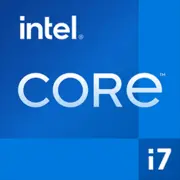Intel Core i7-10610U

Intel Core i7-10610U: Review of the 2025 Ultrabook Processor
April 2025
Despite the emergence of more modern chips, Intel's 10th generation processors, such as the Core i7-10610U, are still found in budget and business laptops. Let's explore who should pay attention to this CPU in 2025, its strengths, and where it falls short against competitors.
Architecture and Process Technology: 14 nm in the Era of 5 nm
Comet Lake: The Final Note of the 14-nm Era
The Core i7-10610U belongs to the Comet Lake family, released in 2019–2020. It is one of the last Intel architectures on the 14-nm process, which by 2025 feels outdated compared to Apple's 5-nm M3 chips or AMD's 4-nm Zen 5. However, the "older" technology has its advantage: established stability and compatibility with most platforms.
CPU and iGPU Features
- Cores and Threads: 4 cores, 8 threads (Hyper-Threading).
- Frequencies: Base - 1.8 GHz, maximum Turbo Boost - 4.9 GHz (single core).
- Cache: 8 MB L3.
- Integrated Graphics: Intel UHD Graphics (10th generation) with 24 execution units (EUs) and a frequency of up to 1.15 GHz.
The UHD graphics are suitable only for basic tasks: working with office applications, watching 4K videos, and light games like Among Us or Stardew Valley. In comparison, the Iris Xe in Intel's 11th generation offered up to 96 EUs, and the Radeon 780M in the AMD Ryzen 7 7840U has three times as many compute units.
Power Consumption and TDP: A Balance Between Power and Battery Life
TDP 15 W: A Standard for Ultrabooks
The processor is designed for thin laptops with passive or modest active cooling. In theory, 15 W is the average power consumption, but under peak loads (e.g., during rendering), the chip can temporarily draw up to 25 W.
Energy-Saving Technologies
- Intel Speed Shift: Dynamic switching between P-states (performance states) to reduce latency.
- Adaptix Thermal Framework: Temperature management through algorithms that limit frequencies when overheating.
Performance: What Can the Core i7-10610U Do in 2025?
Office Tasks and Multimedia
- Microsoft Office, Browsers: Loading 10–20 tabs in Chrome + working in Excel causes no issues.
- Video Conferencing: The chip handles Zoom + simultaneous 1080p streaming.
- Photo Editors: Adobe Lightroom runs comfortably, but there are delays during batch processing of RAW files.
Gaming
- CS2 (Low settings): 30–40 FPS at 1280×720 resolution.
- The Sims 4: 50–60 FPS at 1080p.
- Turbo Mode: In devices with efficient cooling (e.g., Dell XPS 13 9310), the frequency can maintain levels of 3.8–4.2 GHz for 3–5 minutes.
Use Cases: Who Is This Processor Suitable For?
1. Students and Office Workers: For document work, online courses, video calls.
2. Users Who Value Portability: Laptops weighing 1.2–1.5 kg with a 13–14 inch screen (e.g., HP EliteBook 840 G7).
3. Those Who Value Compatibility: Windows software, enterprise applications, outdated equipment (printers, scanners).
Not Suitable For:
- Gamers — discrete GPUs are required.
- Engineers and Designers — insufficient power for 3D modeling or 4K video editing.
Battery Life: How Long Will the Laptop Last?
Examples of Operating Time (with a 50–60 Wh battery):
- Web Surfing: 8–10 hours.
- Video (1080p): 12 hours.
- Load (Photoshop + browser): 3–4 hours.
Factors Affecting Battery Life:
- Screen Brightness: Reducing from 300 nits to 150 nits adds ~1.5 hours.
- Background Processes: Applications like Slack or antivirus reduce runtime by 10–15%.
Comparison with Competitors: AMD, Apple, and Previous Intel Generations
1. AMD Ryzen 5 5500U (Zen 2, 7 nm):
- Better in multi-threaded tasks (+20% in Cinebench R23).
- Vega 7 graphics outperform UHD by 40–50%.
- But has poorer optimization for Windows 11.
2. Apple M1 (5 nm):
- Twice the energy efficiency.
- Better graphics (8 GPU cores).
- Limited compatibility with Windows.
3. Intel Core i5-1135G7 (11th generation):
- Newer Iris Xe graphics (up to 80 EUs).
- Support for PCIe 4.0.
Pros and Cons of Core i7-10610U
Pros:
- Stability and compatibility with Windows.
- High single-thread performance (Geekbench 6 Single Core — 1187).
- Support for Thunderbolt 3.
Cons:
- Outdated 14-nm process technology.
- Weak integrated graphics.
- Heating under prolonged loads.
Recommendations for Laptop Selection
Device Types:
- Ultrabooks: Dell XPS 13, Lenovo ThinkPad X1 Carbon (price: $800–$1200).
- Business Laptops: HP EliteBook 850, ASUS ExpertBook B9.
What to Look For:
1. Cooling: 2 fans + copper pipes are better than passive cooling.
2. RAM: At least 16 GB DDR4.
3. Ports: Presence of Thunderbolt 3 for connecting external GPUs or 4K monitors.
Final Conclusion
The Intel Core i7-10610U in 2025 is a choice for those who:
- Are looking for a budget laptop (under $1000) for work and study.
- Value compatibility with the Windows ecosystem.
- Do not plan to run heavy applications or games.
Alternatives:
- If the budget allows — AMD Ryzen 5 7530U or Intel Core i5-1240P.
- For maximum battery life — MacBook Air M1 (starting at $999).
Despite its age, the Core i7-10610U remains a reliable option, but only if you are willing to accept its limitations in graphics and energy efficiency.
Basic
CPU Specifications
Memory Specifications
GPU Specifications
Miscellaneous
Benchmarks
Compared to Other CPU
Share in social media
Or Link To Us
<a href="https://cputronic.com/cpu/intel-core-i7-10610u" target="_blank">Intel Core i7-10610U</a>